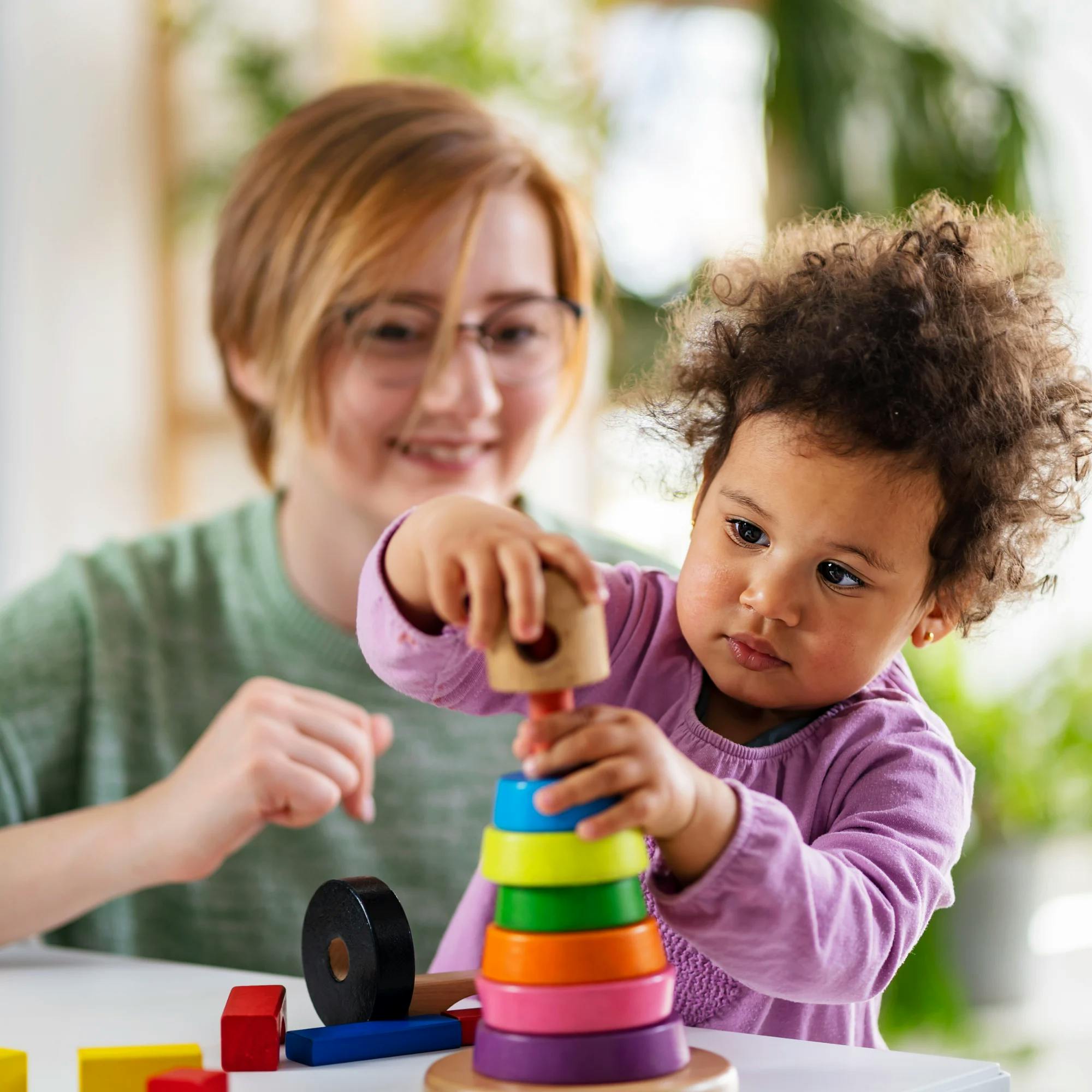
10 Tips to Improve Expressive Language for Children with Autism Spectrum Disorder (ASD)

Expressive language is how we express our wants and needs to others with verbal or nonverbal communication.
Many children diagnosed with autism spectrum disorder (ASD) may struggle to use expressive language and communicate their feelings. They may talk very little for their age or not at all, have trouble starting or maintaining a conversation, or repeat words or phases they just heard.
Not only can these language barriers be frustrating for the child and their caregiver, it can also lead to challenging behaviors like crying or temper tantrums. Children often resort to these behaviors when they’re unable to use words or gestures to communicate.
Fortunately, there are many helpful tips and strategies you can use at home from a very early age to improve your child’s expressive language abilities.
Be sure to see our article on helping improve receptive language in autistic children, as well.


1 Get ready to be silly
Autistic kids often need increased stimulation in order to respond.
Ideally we want them to verbally make requests, comment on what they see, and label items and objects independently. However, sometimes we need to start with the basics. This involves increasing your child’s verbal imitation skills. The more your child copies or repeats what you do and say, the more likely they’ll be able to do it themselves!
One helpful trick is to stop thinking like an adult and start thinking like a child. What makes your child laugh? What engages them? Probably a funny sound like making a raspberry on their arm or a silly face. Participate in these activities often with your child and encourage them to imitate your actions.
Another great activity to increase this verbal imitation is spending time in front of a mirror. While an autistic child may struggle with direct imitation or eye contact, they will more likely follow your lead in the mirror. Try to incorporate mirror time into the daily routines your child is already doing, like taking a bath or getting ready for bed. In addition to helping with imitation, spending a few minutes every day making silly faces and sounds in the mirror will help engage your child and expand their attention and focus. We want them to feel comfortable attempting to imitate. Seeing you being silly gives them the green light to try!
2 Go low-tech with less screen time
Let’s face it, parents are really busy. And sometimes it can be hard to keep an autistic child content and occupied throughout the day.
Caregivers often remark how easily their toddler can navigate their device to find their favorite videos online. They may also enjoy pushing buttons and activating the lights and sounds of a favorite toy. But does all this really promote language?
Studies have proven that reducing screen time and electronic toy play increases language acquisition. Often, an autistic child is not functionally using a device; rather, they are “stimming” on it. This means they are scrolling and/or tapping in a cause-and-effect manner rather than completing a task.
For instance, they may have a favorite fire truck that produces a sound or light when a button is pressed. Sure, when they press that button over and over again, it holds their attention, but don’t we want the child to make that siren sound instead of just hearing it?
As another example, your child may enjoy an online video so much they watch it repeatedly. While it’s impressive that children can navigate devices so easily and are expressing a fondness for the characters on screen, their focus should be on experimenting with their own sounds and words versus simply listening to others.
While limiting screen time can be challenging, it encourages a child to be creative and make sounds on their own.
While limiting screen time can be challenging, it encourages a child to be creative and make sounds on their own. Try removing the batteries from the fire truck and see if your child starts making the siren sound on their own. You might be surprised!
3 Use simple sign language
But my child isn’t hard of hearing!
Don’t worry--in early intervention, and even when working with older autistic children, speech therapists often use basic sign language as a method of communication. Why do we do that when our goal is to help children verbally express themselves? Because it’s often easier to make a gesture than it is to plan the verbal production of that same word, especially for a toddler. Using a gesture along with the verbal request serves to reinforce the word. Typically, as the child begins to verbally request, these gestures fade out.
Start teaching gestures for basic words: more, open, all done, help. These are all easy to imitate. If your child allows, place your hand over theirs and guide them through the motions to reinforce these requests.
4 Give your child chances to request
An autistic child can often appear self-sufficient. They may know where their favorite toys are or can go to the fridge and get their own snack. In short, sometimes they don’t even need to use their words or language to get what they want.
This may sound odd, but one trick to encourage your child to use language is to get them a little frustrated. I know what you’re thinking: what parent wants a frustrated kid? Well, a little bit of frustration can actually motivate them to use words. While being self-sufficient is fantastic, being able to ask for an apple is even better.
One trick to encourage your child to use language is to get them a little frustrated.
To do this, try putting your child’s toys slightly out of reach, or make sure they don’t have easy access to the snack drawer. By making these simple tasks more challenging for an autistic child, you’re providing them with opportunities to request, even if it simply means they pull you over to the fridge and point.
Another technique to increase language is giving your child choices. Caregivers are great at anticipating their child’s needs--after all, who knows their child better than their family? That's why it can be incredibly helpful to give your child a choice of two.
For instance, let's say your child wants a snack and you know they want some crackers. Give them a choice between crackers and something they definitely do not want. Hold both up and say, “Do you want the crackers or the carrots?” This gets them in the habit of pointing to what they want, and you can quickly follow up with verbal confirmation: “You wanted the crackers!”
Eventually, as this skill becomes more established, trying holding out until they make a verbal request. “Did you want the carrots or the crackers? Good pointing, but can you use your words? Carrot or crackers?”
When they speak, even if it doesn’t sound perfect, this is great progress! You can respond, “I heard you. You wanted the crackers! That was a great try! Thank you for using your words! Here you go!”


5 Teach your child to use more words
If your child has begun using single words and gestures, how do we get to them to the next step in their language development?
We want to begin combining established words into simple phrases. For example, the words “more” and “drink” become “more drink.” Combining two established words and/or gestures, confirming the attempt, and providing praise will encourage a child to continue to use and develop more complex language skills to express their needs.
6 Put it all together
In our tips above, we discussed the importance of providing choices and increasing language opportunities throughout your child’s daily routines. Let’s try putting these two techniques together.
Let’s say you’re giving your child a choice of two activities: “Do you want the ball or bubbles? You want bubbles!”
Before giving your child the bubbles, make sure the lid is on tight. They may experience some temporary frustration trying to get it open, which should encourage them to hand it back to you. “You need me to open?”
Again, you’re creating another opportunity for your child to request either verbally or with a simple gesture.
If your child is expecting you to blow the bubbles, don’t do it immediately. Wait expectantly until they request it. “More bubbles?” Even a head nod can lead to a child saying “yes." Create as many opportunities as you can during an activity and throughout the day for your child to practice communicating.


7 Sing a song
For autistic children, we want to increase opportunities to use their voice. Music is a great way for children to discover their voice and to experiment with sound.
Does your child have a favorite cartoon theme tune? Do they love “Head, Shoulders, Knees and Toes?” Children’s songs often include gestures that are simple and repetitive.
If your child has difficulty staying in one place, incorporate some wiggles into the song. If your child is not singing the whole phrase, leave it open ended for them to complete. For example, you could say “Old MacDonald had a farm-“ giving them the opportunity to complete the lyric.
Add some extra fun to singing! Grab some pots and pans and bang along to the song. This is an easy way to increase that expressive language and encourage your child to vocalize.


8 Use visual cues
For some autistic kids, communicating verbally can be a big challenge. While we can encourage them to express themselves verbally, sometimes we need to think of other strategies to help them communicate their thoughts.
One helpful technique is by setting up a board that displays item they can request, such as foods, toys, and activities. It's also important to model these words as well. For example, you can say, “I want book” and put the picture of the book on the board and then ask the child what they want. “You wanted to play trains! Good idea!”


9 Use positive reinforcement: "You did it!"
We all respond to positive reinforcement. By encouraging your child to use their words in whatever form that takes, and praising them for their attempts, you’re creating a safe environment for them to experiment.
Whether it's pointing, using a picture board, or using a word or gesture, it's the attempt that matters. While the goal for your child is to better express themselves, your job is to encourage it!


10 Keep track of what you're working on
Putting a list of new words on the fridge helps a parent to keep track of all the new words a child is using. Not only will you be able to expand on this expressive language, but you’ll be able to determine what new words might be helpful to introduce.
Again, start with the fundamentals and build from there. If your child is telling you “no,” which for many toddlers is probably their favorite word, then work on “yes.” Keeping a list of all these new words not only helps expand vocabulary, but shows how much your child has accomplished.
Caregivers often worry about how many words their child is using. That's typically what initially leads them to seeking a diagnosis of autism. While it's easy to get stuck on that number, the goal should always be to have a happy, healthy child who is able to express themselves. Using these basic methods creates a safe environment for an autistic child to express themselves and build a strong foundation for a language-rich future. An important note: We believe that when speaking about any community as a whole, the best approach is to prioritize that community’s voices, needs, and preferences. Within the larger autism community, the current language preference is identity-first, which is why we use that language in our content. Expressable is committed to listening to and learning from the populations we serve. If and when their preferences change, we’ll adjust our approach accordingly.













